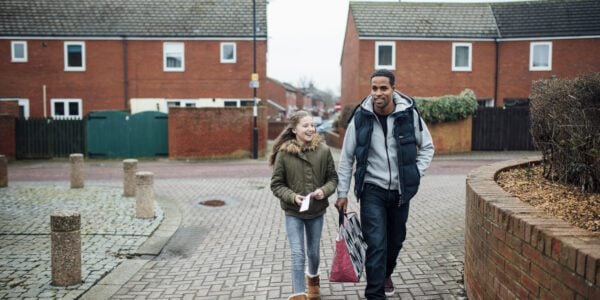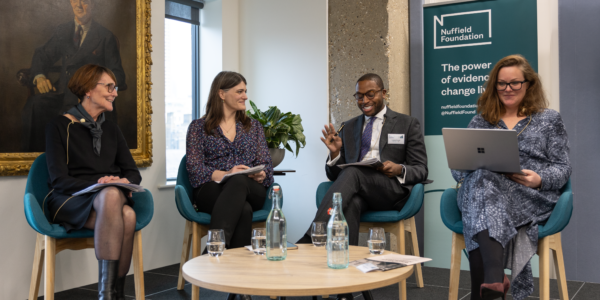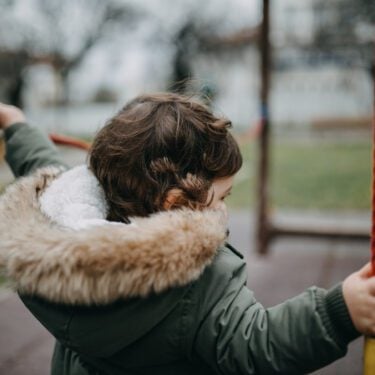
15/12/20
8 min read
As we move into winter with significant restrictions still in place across the UK, it is hard to identify any area of life that has been untouched by the pandemic.
In the first weeks of the pandemic, in anticipation that it would be more than a health shock, the Foundation reacted by issuing a call to social scientists to capture ‘in real time the experience of the social, cultural and economic effects’. Research teams responded rapidly enabling us to award eleven grants for new projects, and to adapt several projects already underway, focusing across our interests in education, justice and welfare. Individually, projects continue to inform key policy and practice discussions, however together they give us a multifaceted perspective of the crisis. Here we reflect on what has emerged to date regarding variations in experience of the pandemic, the extent to which public institutions have provided a safety net, and the reverberations we might expect through the coming months and years.
What has shaped our experience of the pandemic?
One after another our projects have revealed that being in a disadvantaged position prior to the pandemic has made the experience a more difficult one and that disadvantages have frequently intersected and been compounded. The Nuffield-funded IFS Deaton Review of Inequalities got underway in 2019, providing a significant vantage point for understanding the impact of the crisis. Review panel member Paul Johnson quickly observed ‘We may be in this together, but that doesn’t mean we are in this equally’.
Early analysis by Lucinda Platt and Ross Warwick for the Deaton Review explored factors that might explain why some ethnic minority groups were emerging as being over-represented in hospital deaths from the virus, despite age and geographic profiles that should have made them less at risk, and the variation in vulnerability to the economic shocks. Platt warned against aggregating ethnic groups together as this will ignore important differences and that there is ‘no single narrative that can describe or account for the impacts of the current crisis on all minority groups.’
Alex Davenport and colleagues, also for the Deaton Review, described geographic variations in risks from the pandemic. They identified local authorities whose residents would be particularly vulnerable to the health effects of COVID-19, authorities likely to be hardest hit on jobs, and authorities with a larger share of children and families who may be most vulnerable to impacts on well-being, with some local areas likely to be affected on two, or even all three, dimensions. They highlighted that standard measures of deprivation won’t effectively identify these locations and, in analysis for the IFS Green Budget, that those areas most exposed to the immediate economic impacts of the crisis are not the same as those considered as ‘left-behind’.
Economic inequalities have been illuminated, for example, showing through in challenges in meeting basic needs during lockdown, levels of life satisfaction and consumption of news about the pandemic. They have been strongly evident in education. Although almost all children and young people missed time in school during the lockdown period, those inlow-income familieswere worst hit. The National Foundation for Educational Research (NFER) moved rapidly to survey school leaders and teachers across England in May and July. By the end of the summer term, 53 per cent of teachers in the most deprived schools expected that their pupils were four months or more behind in their learning, compared to 15 per cent in the least deprived.
The extent to which support from home was able to fill the gaps in schooling differed according to family resources. Sarah Cattan and colleagues from the IFS surveyed over 5,000 parents about home learning during the lockdown period. They found that fewer primary and secondary age children from the poorest third of families had access to study space or a computer or tablet at home. More parents in the poorest third were finding it hard to support secondary school children with home learning. This is against a backdrop where parents in the lowest income families were more likely to have experienced their own work disruptions, either through furlough or permanently losing their jobs, with all the stresses this would bring. The experience of lockdown also varied according to the gender of parents. Mothers were more likely than fathers to have left paid work since February, or to have their hours reduced. For those remaining in work, mothers were more likely than fathers to be spending work hours juggling caring for children.
A complex pattern of generational inequalities also emerged in the first months of the crisis. The Resolution Foundation’s Intergenerational Audit revealed that though older people have suffered the worst physical health outcomes, young adults and older workers have been more likely to experience the broader effects of the pandemic. These age groups have seen the biggest deteriorations in their mental health and employment situations: more than half of under-25s and over 65s who were employed before the pandemic had experienced furloughing or were out of work in June. Based on long-terms trends, younger people are the age group who experienced the worst living conditions during lockdown, living in poorer quality housing with potential impacts on well-being; there were also striking differences within age groups according to household income and ethnicity.
Daisy Fancourt’s COVID-19 Social Study, launched in the week before the first lockdown and involving over 70,000 adults, is continuing to track levels of psychological well-being. The study finds that under-30s, who have higher prevalence in normal times, are the age group most likely to be experiencing mental health problems. During lockdown they described feeling less in control of finances, relationships, and future plans and being lonelier, all of which may have contributed. Women, those with lower incomes and people from ethnic minorities also have comparatively higher levels of mental health problems that have persisted over time.
How have public institutions responded?
Our projects have explored the extent to which public institutions have been able to meet the needs of those already, or made newly, vulnerable during the crisis. Sarah Cattan and colleagues observed that as schools closed, children were losing a ‘protective, and (at least partly) equalising environment’ increasing the significance of their situation at home. However, schools in deprived areas gave less support for learning than those in more affluent areas, and children in low-income families were less likely to receive active learning resources, such as online classes. In July, despite a government promise in April to supply devices to a range of vulnerable pupils, NFER’s survey of senior teachers found that 28 per cent of their pupils still had little to no IT access in the home. Analysis by Luke Sibieta for the Education Policy Institute (EPI) showed that challenges around attendance continued into the new school year, and, in Scotland where more detailed data is available, that school attendance is lower in disadvantaged areas.
Parents’ and teachers’ concerns about safety meant that significant numbers of those attending special schools were not expected to return to education in the Autumn term (with EPI’s analysis confirming that this was the reality). Amy Skipp and colleagues at ASK Research and NFER found that insufficient staff capacity, limited space, limited funding and reliance on external agencies such as social services and student transport to adapt were all expected to affect the support provided to pupils with special educational needs.
The Nuffield Family Justice Observatory (Nuffield FJO) has placed a spotlight on support provided to vulnerable families during the pandemic through the Family Justice System. Working with Elsbeth Neil at the University of East Anglia, the Nuffield FJO found that many children and young people in the care of local authorities experienced disruption to arrangements for face-to-face contact with their birth relatives, with contact moving online with varied success (in general remote contact worked better for older children). Nuffield FJO’s consultation on the rapid adjustment of family court hearings to operate remotely, found a mixed picture. While certain types of hearings were widely regarded to be more efficient when conducted by phone or video, where vulnerable parties were involved, or hearings were contested, there were serious concerns about the fairness of decisions being made as parents are not always able to participate fully. Two in five parents and relatives in their survey said they had not understood what had happened during the hearing.
Analysis for the IFS Green Budget recognised that the government’s interventions have played an ‘enormous’ role in protecting people in the labour market since March. However, there has been rapid growth in families receiving means tested benefits: 1.6 million additional families were claiming Universal Credit in May. Ruth Patrick’s in-depth research with families living on low incomes found that new pressures caused by the pandemic were not offset by support from the welfare system. Families continued to find it hard to cover living costs, and emergency charitable provision remained essential. Ongoing structural problems with Universal Credit, the return of conditionality in July, requirements for phone contact with advisors, and the stigma of being in receipt of benefits were all increasing stress.
What might be the lasting impact across society?
It is anticipated that these effects of the pandemic will reverberate across the coming years unless policy interventions work efficiently to mitigate risk. Our projects make some initial recommendations as to how these should be targeted.
The IFS highlights that differences in learning time, learning resources, and home environments experienced during the pandemic have the potential to expand already existing inequalities in children’s outcomes. Alex Davenport and colleagues warn that ‘it could take years or even decades for the full impact of children’s vulnerability to school closures to be felt’. Although additional funds will be available to all schools, the National Tutoring Programme is specifically targeted to narrow the attainment gap (the Nuffield Early Language Intervention is a significant part, aimed particularly at the cohort of disadvantaged pupils entering primary school in the current school year). However, in July only two in five senior leaders responding to NFER’s survey planned to access support for disadvantaged pupils. Those undecided were concerned about using unfamiliar tutors, having sufficient budget to contribute to costs, the quality of tutors, and alignment between tutoring and in school teaching. The IFS Annual Report on Education Spending in England describes the programme as ‘modest compared with the likely reductions in skills’, seeing a strong case for greater targeting of additional funding to more deprived schools. NFER warn that education catch up needs to run over the long-term rather than be approached as a ‘quick fix’, and Will Cook and colleagues caution that careful evaluation is needed.
Young people in Ecorys’s seven-country study are anxious about the longer term consequences of their missed education and their futures in what they expect will be a challenging economic climate. The Resolution Foundation anticipate that younger adults are likely to be the hardest hit, with their jobs concentrated in the sectors most affected; potential employment and pay ‘scarring’ as they try to start careers; withdrawal of temporary welfare payments; and home ownership staying out of reach. They return to earlier recommendations that policy should be aimed at restarting ‘cohort-on-cohort living standards improvements’, with interventions to improve educational attainment, housing security, higher home ownership among the young and pension saving rates. For all age groups, Daisy Fancourt anticipates that rises in unemployment, poverty and recession will make it likely that the mental and physical health impacts of the pandemic will stretch into the longer term.
In June Richard Blundell and colleagues, writing for the IFS Deaton Review, already anticipated that the pandemic might move us back, at least initially, in key areas including gender equality, and the Government’s goal of ‘levelling up’ prosperity across the UK, recommending that effective preventative policy responses are required. Alex Davenport and colleagues, conclude that differing local needs will require targeted and coordinated responses drawing across a range of services and levels of government; this will require ongoing financial support at local level and recognition that effects of the pandemic may emerge and compound over time.
The longer-term consequences are yet to play out, but findings from projects including those led by Daisy Fancourt, Joe Tomlinson, Dominic Abrams, and Rasmus Nielsen raise questions about impacts of the pandemic on outcomes that are initially less tangible, including trust, community cohesion, compliance, and individual rights. Confidence in government to handle the pandemic declined rapidly from April to June in England. The initial ‘rally around the UK government’ quickly evaporated, with trust in government and politicians as a source of information about the pandemic falling dramatically from April into August (trust in news also declined, though less dramatically). Encouragingly Dominic Abrams suggests that communities where there has been investment in social cohesion ‘appear better set up to weather the storm of COVID-19’. We will return to consider potential implications for how we relate to one another and to public institutions in a future update, but we anticipate that there could be significant lasting impacts.
The policy challenges arising from a pandemic that has cut into every element of our individual and collective well-being are massive and will interact with the as yet unknown effects of Brexit. As highlighted by the Deaton Review, there is opportunity for an inclusive recovery that could fundamentally tackle inequalities in our society. This would require considerable realignment and reinforcement of the systems, such as education and welfare, that provide a safeguard for those in most need. The Government must pay heed to what the evidence is telling us about how the pandemic is exacerbating existing fault lines, creating new ones and where intervention should be targeted.
Related publication
About the author
Catherine joined the Nuffield Foundation’s Welfare team in early 2019, contributing to the development, and management of the grants portfolio. She leads on our digital society grants and manages our Oliver Bird programme of research relating to the impact of musculoskeletal conditions on wider well-being. She has co-ordinated the COVID-19 rapid response call.
Prior to joining the Nuffield Foundation, Catherine managed Research and Policy teams with the sight loss charity RNIB. Previously she worked in the Department of Health as Research Manager with the Children and Young People’s Public Health and Teenage Pregnancy policy teams.






















































